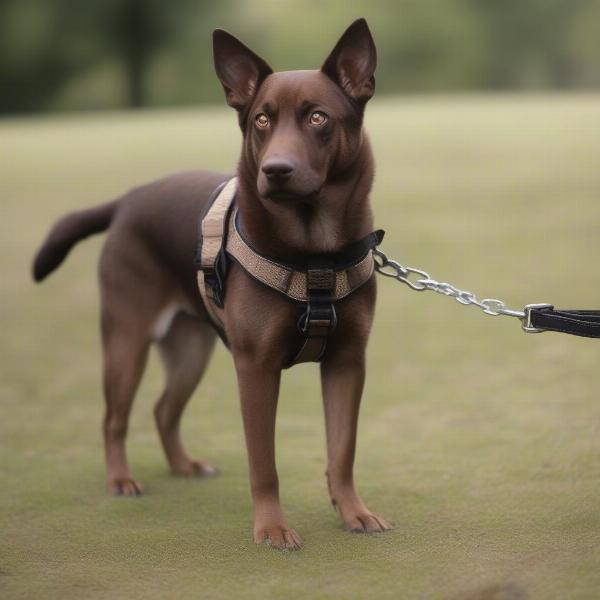Reactive dog leads are a crucial tool for owners of dogs who exhibit reactivity, such as barking, lunging, or growling, towards other dogs or stimuli. Finding the right lead can significantly improve walks, enhance training, and create a more positive experience for both dog and owner. This article will delve into the different types of reactive dog leads available, helping you choose the perfect one for your furry friend.
 Reactive dog on a lead
Reactive dog on a lead
Understanding Your Dog’s Reactivity
Before diving into lead options, it’s important to understand your dog’s specific triggers and level of reactivity. Does your dog react to other dogs, people, or specific objects? How intense are their reactions? This information will guide you towards the most suitable lead features. For example, a dog with mild reactivity might benefit from a standard lead with added features like a traffic handle, while a dog with more intense reactions may require a double-ended lead or a front-clip harness.
Types of Reactive Dog Leads
Standard Leads
Standard leads are a good starting point for dogs with mild reactivity. Look for durable materials and comfortable handles. A traffic handle, located closer to the dog’s collar, provides extra control in challenging situations. long dog leads uk can also be beneficial for giving your dog more freedom while maintaining control.
Double-Ended Leads
Double-ended leads offer versatility and added control. By attaching one end to the collar and the other to a harness, you can distribute pressure evenly and prevent pulling. This type of lead is especially useful for dogs that tend to lunge or pull strongly.
Slip Leads
While slip leads can be effective for training, they should be used with caution for reactive dogs. The tightening action of a slip lead can exacerbate reactivity in some dogs. If you choose to use a slip lead, ensure you have proper training and use gentle handling techniques.
Bungee Leads
Bungee leads provide a bit of give, absorbing some of the shock from sudden lunges and reducing strain on both the dog and owner. However, for highly reactive dogs, the added bounce can sometimes make it more challenging to maintain control.
Harness Considerations for Reactive Dogs
A harness is often used in conjunction with a reactive dog lead. Front-clip harnesses can help redirect a dog’s pulling force, making it easier to manage their reactivity. hardware dog collars may not be suitable for reactive dogs as they can put pressure on the neck and exacerbate reactivity.
Training and Management Techniques
While the right reactive dog lead can be a valuable tool, it’s crucial to combine it with appropriate training and management techniques. Positive reinforcement methods, such as rewarding calm behavior, can help your dog learn to cope with triggers. Creating distance from triggers and avoiding overwhelming situations is also essential. dog friendly walks can be helpful in providing a safe and controlled environment for training and socialization.
Expert Insight
Dr. Emily Carter, a certified veterinary behaviorist, emphasizes the importance of a personalized approach. “Choosing a reactive dog lead is not a one-size-fits-all solution,” she explains. “It’s crucial to consider your dog’s individual needs and work with a qualified trainer to develop a comprehensive management plan.”
John Smith, a professional dog trainer with over 20 years of experience, adds, “The right lead, combined with consistent training and management, can make a world of difference for reactive dogs and their owners.” dog chain lead should only be used under the guidance of a professional trainer, as they can be aversive.
Conclusion
Finding the right reactive dog lead is a significant step towards managing your dog’s reactivity and improving your walks together. By considering your dog’s individual needs, exploring different lead options, and implementing appropriate training techniques, you can create a more positive and enjoyable experience for both you and your furry companion. Remember to consult with a professional trainer or behaviorist for personalized guidance.
FAQ
- What is the best lead for a reactive dog? There is no single “best” lead. The ideal lead depends on your dog’s individual needs and reactivity level.
- Can a harness help with reactivity? A front-clip harness can be helpful in redirecting a dog’s pulling force and making it easier to manage their reactivity.
- Are retractable leads good for reactive dogs? Retractable leads are generally not recommended for reactive dogs as they can provide less control and increase the risk of injury.
- How can I train my reactive dog? Positive reinforcement methods and working with a qualified trainer are essential for training a reactive dog.
- What should I do if my dog reacts on a walk? Create distance from the trigger, use positive reinforcement to reward calm behavior, and seek professional guidance if needed.
- Are slip leads safe for reactive dogs? Slip leads can exacerbate reactivity in some dogs and should be used with caution and proper training.
- Can a special lead cure reactivity? A lead is a management tool, not a cure. Training and behavior modification are necessary to address the underlying causes of reactivity.
About ILM Dog: ILM Dog is your trusted resource for expert advice on all aspects of dog care, from breed selection and health to training, nutrition, grooming, and accessories. We are dedicated to providing dog owners worldwide with reliable, practical information and helping them build stronger bonds with their furry companions. Whether you need guidance on choosing the right products like dog groomers nuneaton, or expert insights on dog behavior, we are here to help. Contact us today at [email protected] or +44 20-3965-8624 for personalized advice and support.